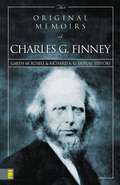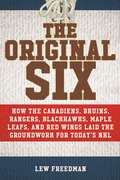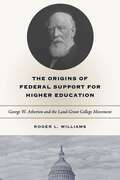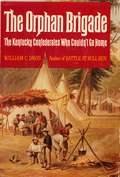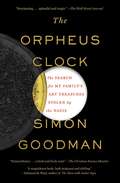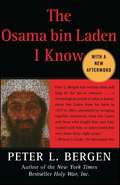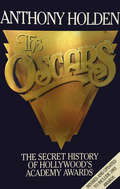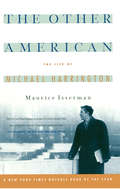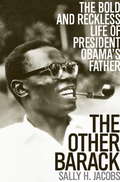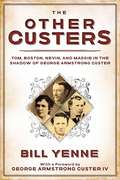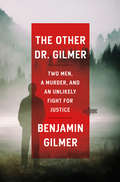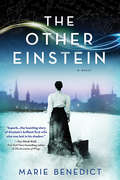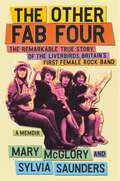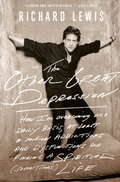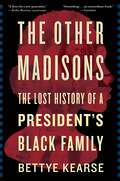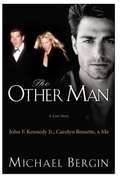- Table View
- List View
The Original Has This Signature--W. K. Kellogg
by Horace B. PowellThe Story of a Pioneer in Industry and Philanthropy--W. K. Kellogg,who built a world-wide cereal industry and amassed one of the great fortunes of the twentieth century and reinvested his fortune in a philanthropic foundation designed to help people to help themselves.
The Original Memoirs of Charles G. Finney
by Garth M. Rosell Richard DupuisIn 1989, the first complete, restored text of revivalist Charles Finney’s memoirs was published by Zondervan. Until then, all editions had reflected editorial liberties introduced in the first 19th-century publication, edited after Finney’s death. The restored text—the culmination of over ten years of research by editors Garth Rosell and Richard Dupuis—brought to light Finney’s entire memoirs in their original language. Longstanding omissions and inaccuracies were corrected. Comprehensive annotations supplied detailed, phrase-by-phrase and even word-by-word explanations. The 1989 edition was a scholar’s and historian’s delight. However, the average reader who simply wants to read what Finney wrote doesn’t need the scholarly minutiae. This new edition provides the complete, restored text of Finney’s memoirs with no unnecessary details to obstruct a straightforward read. In bold, untouched language, Finney’s thoughts march across the page with fascinating clarity and cohesiveness. For students of revival or anyone interested in the life of one of America’s foremost evangelists, here in his own words is Charles Finney: his life, his thoughts, his struggles and accomplishments, and his abiding love for God and enduring commitment to the gospel of Christ.
The Original Six: How the Canadiens, Bruins, Rangers, Blackhawks, Maple Leafs, and Red Wings Laid the Groundwork for Today?s National Hockey League
by Lew FreedmanSince the inception of the National Hockey League on November 26, 1917, the sport of hockey has been one of the most popular games across the globe.After the National Hockey Association (NHA), which had been founded in 1909, ceased operations, the NHL took over and became a mainstay for the sport. While there had been teams that dated back to the 1800s and many that came and went through the years, there are six teams which are considered to be the Original or Traditional Six: the Montreal Canadiens, Boston Bruins, New York Rangers, Chicago Blackhawks, Toronto Maple Leafs, and Detroit Red Wings.In The Original Six, Lew Freedman (Clouds Over the Goalpost, A Summer to Remember) takes readers on a trip down memory lane, not only introducing the NHL’s humble beginnings, but how far the game has actually come.Broken up into six sections, Freedman tells the history and stories of the teams that represent the heart and soul of the NHL. From how these teams came to be and the steps that were taken to get them established to their early years and how they helped shape the game we love today, The Original Six is not only for lover’s of these teams, but for the sport itself.Whether you’re a diehard supporter or fair-weather fan, learn how this incredible sport began and of the teams that helped it grow into one of the most entertaining and enjoyable games in the world.Skyhorse Publishing, as well as our Sports Publishing imprint, are proud to publish a broad range of books for readers interested in sports-books about baseball, pro football, college football, pro and college basketball, hockey, or soccer, we have a book about your sport or your team.Whether you are a New York Yankees fan or hail from Red Sox nation; whether you are a die-hard Green Bay Packers or Dallas Cowboys fan; whether you root for the Kentucky Wildcats, Louisville Cardinals, UCLA Bruins, or Kansas Jayhawks; whether you route for the Boston Bruins, Toronto Maple Leafs, Montreal Canadiens, or Los Angeles Kings; we have a book for you. While not every title we publish becomes a New York Times bestseller or a national bestseller, we are committed to publishing books on subjects that are sometimes overlooked by other publishers and to authors whose work might not otherwise find a home.
The Origins of Federal Support for Higher Education: George W. Atherton and the Land-Grant College Movement
by Roger L. WilliamsThe Origins of Federal Support for Higher Education revises the traditional interpretation of the land-grant college movement, whose institutions were brought into being by the 1862 Morrill Act to provide for "the liberal and practical education of the industrial classes." Rather than being the inevitable consequence of the unfolding dynamic of institutional and socioeconomic forces, Williams argues, it was the active intervention and initiative of a handful of educational leaders that secured the colleges' future—above all, the activities of George W. Atherton.For nearly three decades, Atherton, who was the seventh president of the Pennsylvania State University, worked to secure consistent federal financial support for the colleges, which in their early years received little assistance from the states they were designed to benefit. He also helped to develop the institutions as comprehensive "national" universities grounded in the liberal arts and sciences—a conception that countered the prevailing view of the colleges as mainly agricultural schools.Atherton became the prime mover in the campaign to enact the 1887 Hatch Act, which encouraged the establishment of agricultural experiment stations at land-grant colleges. The act marked the federal government's first effort to provide continuous funding to research units associated with higher education institutions. At the same times, Atherton played a key role in the formation of the first association of such institutions: The Association of American Agricultural Colleges and Experiment Stations. It was the Association that provided the critical mass needed to lobby Congress successively and to approach the many opportunities and threats the land-grant colleges faced during the 1885–1906 period.Atherton was also deeply involved in the campaign for the Morrill Act of 1890, which provided long-sought annual appropriations to land-grant colleges for a broad range of academic programs and encouraged steady growth in state support during the 1890s.Roger Williams traces the motives and tactics behind a series of laws that made the federal government irreversibly committed to funding higher education and scientific research and provides rich new insights into the complexities, polarities, and inherent contradictions of the history of the American land-grant movement.
The Orphan Brigade: The Kentucky Confederates Who Couldn't Go Home
by William C. DavisOn September 18, 1861, ominous sounds of battle thundering in the distance, the Kentucky legislature voted to align itself with the Union. It was a decision which tore at the heart of the state, splitting apart families and severing friendships. For the newly formed First Kentucky Brigade, it marked a four-year separation from the beloved homeland. Fiercely independent to the end, these men would fight for the cause of the South. With their first march into battle, they became outcasts from their mother state -- orphans in the raging strife of civil war. William C. Davis has written a gripping story of the rebel troops whose remarkable spirit and tenacity were heralded throughout the Confederacy. The First Kentucky Brigade was "baptized in fire and blood" at the Battle of Shiloh and went on to serve with great distinction at Vicksburg, Baton Rouge, Chickamauga, and the fight for Atlanta. In this vivid narrative, the author captures the searing drama of each battle, as well as the unbearable drudgery of the months between. We see men of all backgrounds and ranks coming to grips with the war: some of them, renowned leaders such as John C. Breckinridge; others, young soldiers learning the horror of death for the first time. Drawing from a wealth of documents, memoirs, personal letters, and journals, Davis brings to life the fascinating history of the Civil War's "Orphan Brigade."
The Orphan Keeper
by Camron Wright<p>Seven-year-old Chellamuthu's life--and his destiny--is forever changed when he is kidnapped from his village in Southern India and sold to the Lincoln Home for Homeless Children. His family is desperate to find him, and Chellamuthu anxiously tells the Indian orphanage that he is not an orphan, he has a mother who loves him. But he is told not to worry, he will soon be adopted by a loving family in America. <p>Chellamuthu is suddenly surrounded by a foreign land and a foreign language. He can't tell people that he already has a family and becomes consumed by a single, impossible question: How do I get home? But after more than a decade, home becomes a much more complicated idea as the Indian boy eventually sheds his past and receives a new name: Taj Khyber Rowland. <p>It isn't until Taj meets an Indian family who helps him rediscover his roots, as well as marrying Priya, his wife, who helps him unveil the secrets of his past, that he begins to discover the truth he has all but forgotten. Taj is determined to return to India and begin the quest to find his birth family. But is it too late? Is it possible that his birth mother is still looking for him? And which family does he belong to now? <p>From the best-selling author of The Rent Collector, this is a deeply moving and gripping journey about discovering one's self and the unbreakable family bonds that connect us forever.</p>
The Orpheus Clock
by Simon GoodmanThe passionate, gripping, true story of one man's single-minded quest to reclaim what the Nazis stole from his family, their beloved art collection, and to restore their legacy.Simon Goodman's grandparents came from German-Jewish banking dynasties and perished in concentration camps. And that's almost all he knew about them--his father rarely spoke of their family history or heritage. But when he passed away, and Simon received his father's old papers, a story began to emerge. The Gutmanns, as they were known then, rose from a small Bohemian hamlet to become one of Germany's most powerful banking families. They also amassed a magnificent, world-class art collection that included works by Degas, Renoir, Botticelli, Guardi, and many, many others. But the Nazi regime snatched from them everything they had worked to build: their remarkable art, their immense wealth, their prominent social standing, and their very lives. Simon grew up in London with little knowledge of his father's efforts to recover their family's prized possessions. It was only after his father's death that Simon began to piece together the clues about the Gutmanns' stolen legacy and the Nazi looting machine. He learned much of the collection had gone to Hitler and Hermann Goering; other works had been smuggled through Switzerland, sold and resold to collectors and dealers, with many works now in famous museums. More still had been recovered by Allied forces only to be stolen again by heartless bureaucrats--European governments quietly absorbed thousands of works of art into their own collections. Through painstaking detective work across two continents, Simon has been able to prove that many works belonged to his family, and successfully secure their return. With the help of his family, Simon initiated the first Nazi looting case to be settled in the United States. They also brought about the first major restitution in The Netherlands since the post-war era. Goodman's dramatic story, told with great heart, reveals a rich family history almost obliterated by the Nazis. It is not only the account of a twenty-year long detective hunt for family treasure, but an unforgettable tale of redemption and restoration.
The Osama bin Laden I Know
by Peter BergenThe Osama bin Laden I Know is an unprecedented oral history of Osama bin Laden's rise to revered leader of al Qaeda. Peter Bergen takes the reader onto the battlefields of Afghanistan as bin Laden goes from a shy, quiet teen to a leader; he brings you into Osama's intimate family life as he lives under the radar in Sudan, then Afghanistan; he puts you right in the room for al Qaeda's very first meeting; and he uses eyewitness accounts to relate what bin Laden said, and thought on 9/11 as he watched the twin towers fall. Derived from Bergen's interviews with more than 50 people who know bin Laden personally, from his highschool teacher to an early al Qaeda member who later became a US informant, The Osama bin Laden I Know recounts individual experiences with the man who has declared the US, and its allies, his greatest enemies.
The Oscars
by Anthony HoldenIt is just thirteen inches tall and weighs eight pounds, yet the Oscar has come to exert an hypnotic hold over film performers and audiences alike. This book uses the narrative story of an individual year as the basis of a much broader and historical canvas, to present a portrait of the film world today, and its personalities, finances and power-struggles. It also includes detailed lists of Oscar facts and figures, winners and losers. The author's other books include best-selling biographies of Prince Charles and Laurence Olivier.
The Oscars
by Anthony HoldenIt is just thirteen inches tall and weighs eight pounds, yet the Oscar has come to exert an hypnotic hold over film performers and audiences alike. This book uses the narrative story of an individual year as the basis of a much broader and historical canvas, to present a portrait of the film world today, and its personalities, finances and power-struggles. It also includes detailed lists of Oscar facts and figures, winners and losers. The author's other books include best-selling biographies of Prince Charles and Laurence Olivier.
The Oswalds: An Untold Account of Marina and Lee
by Paul R. GregoryThis “lucid, insightful” memoir by a man who knew Lee Harvey Oswald and his wife offers “an informative view of a killer’s marriage and lethal motivations” (Kirkus Reviews).Merely two hours after the assassination of President John F. Kennedy, television cameras captured police escorting a suspect into Dallas police headquarters. Meanwhile at the University of Oklahoma, watching the coverage in the student center, Paul Gregory scanned the figure in dark trousers and a white V-neck tee shirt and saw the bruised and battered face of Lee Harvey Oswald. Shocked, Gregory said, “I know that man.” In fact, he knew Oswald and his Soviet wife, Marina, better than almost anyone in America.Identified by the FBI as a “known associate of LHO,” Gregory soon faced interrogations by the Secret Service. Later he would testify before the Warren Commission. Here, in The Oswalds, he offers the intimate details of his time spent with Lee and Marina in their run-down duplex in Fort Worth, and candidly assesses the murder that marked a turning point in our history. His riveting recollection includes memories both casual and deadly serious, such as the dinner at his parents’ house introducing Marina to the “Dallas Russians,” a front-yard incident of spousal abuse, and a further rift in the marriage when he revealed to Marina that Oswald was not the dashing, radical intellectual whose Historic Diary would be a publishing sensation. Gregory also gives a fascinating account of his father’s role as an eyewitness to history, serving as Marina’s translator and confidant in the first four days after the assassination.“A definitive personality sketch of Oswald . . . Gregory’s book will stand the test of time.” —Mark Kramer, Director of Cold War Studies, Harvard University
The Other Alcott: A Novel
by Elise HooperA People Magazine and POPSUGAR pick! The fascinating, untold story of May Alcott—Louisa’s youngest sister and an artist in her own right.We all know the story of the March sisters, heroines of Louisa May Alcott’s Little Women. But while everyone cheers on Jo March, based on Louisa herself, Amy March is often the least favorite sister. Now, it’s time to learn the truth about the real “Amy,” Louisa’s sister, May.Stylish, outgoing, creative, May Alcott grows up longing to experience the wide world beyond Concord, Massachusetts. While her sister Louisa crafts stories, May herself is a talented and dedicated artist, taking lessons in Boston, turning down a marriage proposal from a well-off suitor, and facing scorn for entering what is very much a man’s profession.Life for the Alcott family has never been easy, so when Louisa’s Little Women is published, its success eases the financial burdens they’d faced for so many years. Everyone agrees the novel is charming, but May is struck to the core by the portrayal of selfish, spoiled “Amy March.” Is this what her beloved sister really thinks of her?So May embarks on a quest to discover her own true identity, as an artist and a woman. From Boston to Rome, London, and Paris, this brave, talented, and determined woman forges an amazing life of her own, making her so much more than merely “The Other Alcott.”“[May’s] adventures illuminate the world of intrepid female artists in the late 1800s . . . The Other Alcott comes alive in its development of the relationship between Louisa and May.” —The New York Times
The Other American
by Maurice IssermanMost Americans first heard of Michael Harrington with the publication of The Other America, his seminal book on American poverty. Isserman expertly tracks Harrington's beginnings in the Catholic Worke
The Other Barack: The Bold and Reckless Life of President Obama's Father
by Sally JacobsThe life story of the father of the most powerful elected leader in the world is an epic tale, one as daring as it was improbable. The father of the U. S. president, the first Barack Hussein Obama, was born in rural poverty in Kenya. His own father was a dominating figure who worked as a cook for the British colonists and broke with Luo tradition when he converted to the Muslim faith. Their household was a severe one from which Barack’s mother fled in fear for her life. Despite such domestic turmoil, Barack was as fiercely smart as he was intrepid. Admitted to one of Kenya’s premiere private schools, he was later thrown out for his defiant behavior. Adrift in the political churning of Kenya’s pre-independence days, Barack attracted the interest of an American literacy worker who took him under her wing. By day, they worked on the literacy primers that would change the lives of illiterate Africans. By night, they often went dancing in the full glare of disapproval of those racially segregated times. She helped him prepare for college in America and in 1959 paid his first year’s tuition at the University of Hawaii. The first African student on the UH campus, Barack stood out in many respects. One of those was the young white woman, Ann Dunham, whom he began to date. A year after they met, the couple had a son named Barack Hussein Obama II. Barack did not tell his young wife about the two children he had left behind in Kenya, nor did he tell university authorities about his family back home until much later. Luos were often polygamous and Obama saw no need to part with custom. At Harvard University, Barack joined the academic elite and prepared to take his place among the big men in newly independent Kenya. But Barack’s experience at Harvard was emblematic of a life that seesawed between high hopes and cruel frustrations, many of them self-inflicted in drunken furies. Yet the charm, the intellectual brilliance, and the fierce pride in his vision of independent Kenya never flagged. He was a bold and reckless man, whose life courted controversy and ultimately veered fatally out of his control. He was heroic in his ambition, deeply flawed, and, extraordinarily, the father of an American president, the other Barack.
The Other Custers: Tom, Boston, Nevin, and Maggie in the Shadow of George Armstrong Custer
by Bill Yenne George Armstrong Custer IVNot one, not two, but three Custer brothers died at the Little Bighorn—and so did their only sister's husband. Most do not realize that not one, not two, but three Custer brothers died with the 7th Cavalry at the hands of the Sioux and Cheyenne at Little Bighorn in 1876. So too did their nephew and the husband of their only sister. Less than half the immediate Custer family would survive the massacre. This is their story. This book is a must for all those interested in the enduring Custer legend. Where other Custer literature focuses solely on George Armstrong, The Other Custers is the only volume to explore the lives of the Custer siblings in depth. War hero Tom Custer earned two Medals of Honor during the Civil War before riding into the West with his brother. There was the bashful and enigmatic Nevin Custer, and the young Boston Custer, whose one desire in life was to share the adventures of his idolized older brothers. Margaret Custer married into the 7th Cavalry and was widowed at twenty-four when her husband, James Calhoun, was among the dead at the Little Bighorn. The Other Custers traces the upbringing of the family and follows Nevin and Margaret as they carried the Custer name beyond Little Bighorn. The book also uncovers much more detail about the ancestors and descendants of the Custer siblings than is to be found in other Custer biographies.
The Other Dickens
by Lillian NayderCatherine Hogarth married Charles Dickens in 1836, the same year he began serializing his first novel. After 18 years of marriage and 10 children, he pressured her into leaving their home in order to pursue another woman, claiming that she was 'mentally disordered. ' This biography gives details on Catherine Hogarth's family of origin as well as her family of marriage and shows that she was not 'mentally disordered. ' Nayder, professor and chair of English at Bates College, offers insights into the relationships among the four Hogarth sisters and examines the legal and emotional ambiguities of Catherine's position as a 'single wife' in the Victorian age. The book includes b&w historical illustrations. Annotation ©2011 Book News, Inc. , Portland, OR (booknews. com)
The Other Dr. Gilmer: Two Men, a Murder, and an Unlikely Fight for Justice
by Benjamin GilmerA powerful true story about a shocking crime and a mysterious illness that will forever change your notions of how we punish and how we heal—an expansion on one of the most popular This American Life episodes of all time&“A remarkable medical detective story–cum–memoir, grippingly told . . . I was drawn in by every part of it.&”—Atul Gawande, #1 New York Times bestselling author of Being MortalFresh out of medical residency, Dr. Benjamin Gilmer joined a rural North Carolina clinic only to find that its previous doctor shared his last name. Dr. Vince Gilmer was loved and respected by the community—right up until he strangled his ailing father and then returned to the clinic for a regular week of work. Vince&’s eventual arrest for murder shocked his patients. How could their beloved doctor be capable of such violence? The deeper Benjamin looked into Vince&’s case, the more he became obsessed with discovering what pushed a good man toward darkness. When Benjamin visited Vince in prison, he met a man who appeared to be fighting his own mind, constantly twitching and veering into nonsensical tangents. Sentenced to life in prison, Vince had been branded a cold-blooded killer and a &“malingerer&”—a person who fakes an illness. But it was obvious to Benjamin that Vince needed help. Alongside This American Life journalist Sarah Koenig, Benjamin resolved to understand what had happened to his predecessor. Time and again, the pair came up against a prison system that cared little about the mental health of its inmates—despite more than a third of them suffering from mental illness. The Other Dr. Gilmer takes readers on a riveting and heart-wrenching journey through our shared human fallibility, made worse by a prison system that is failing our most vulnerable citizens. With deep compassion and an even deeper sense of justice, Dr. Benjamin Gilmer delves into the mystery of what could make a caring doctor commit a brutal murder. And in the process, his powerful story asks us to answer a profound question: In a country with the highest incarceration rates in the world, what would it look like if we prioritized healing rather than punishment?
The Other Eighties: A Secret History Of America In The Age Of Reagan
by Martin D. BradfordIn this engaging book, Bradford Martin illuminates a different 1980s than many remember―one whose history has been buried under the celebratory narrative of conservative ascendancy. Ronald Reagan looms large in most accounts of the period, encouraging Americans to renounce the activist and liberal politics of the 1960s and '70s and embrace the resurgent conservative wave. But a closer look reveals that a sizable swath of Americans strongly disapproved of Reagan's policies throughout his presidency. With a weakened Democratic Party scurrying for the political center, many expressed their dissatisfaction outside electoral politics. Unlike the civil rights and Vietnam-era protesters, activists of the 1980s often found themselves on the defensive, struggling to preserve the hard-won victories of the previous era. Their successes, then, were not in ushering in a new era of progressive reforms but in effecting change in areas from professional life to popular culture, while beating back an even more forceful political shift to the right.
The Other Einstein: A Novel
by Marie BenedictFrom beloved New York Times and USA Today bestselling author Marie Benedict comes the story of a not-so-famous scientist who not only loved Albert Einstein, but also shaped the theories that brought him lasting renown.In the tradition of Beatriz Williams and Paula McClain, Marie Benedict's The Other Einstein offers us a window into a brilliant, fascinating woman whose light was lost in Einstein's enormous shadow. This novel resurrects Einstein's wife, a brilliant physicist in her own right, whose contribution to the special theory of relativity is hotly debated. Was she simply Einstein's sounding board, an assistant performing complex mathematical equations? Or did she contribute something more?Mitza Maric has always been a little different from other girls. Most twenty-year-olds are wives by now, not studying physics at an elite Zurich university with only male students trying to outdo her clever calculations. But Mitza is smart enough to know that, for her, math is an easier path than marriage. Then fellow student Albert Einstein takes an interest in her, and the world turns sideways. Theirs becomes a partnership of the mind and of the heart, but there might not be room for more than one genius in a marriage.Marie Benedict illuminates one pioneering woman in STEM, returning her to the forefront of history's most famous scientists."The Other Einstein takes you into Mileva's heart, mind, and study as she tries to forge a place for herself in a scientific world dominated by men."—BustleRecommended by PopSugar, Bustle, Booklist, Library Journal and more!Other Bestselling Historical Fiction from Marie Benedict:The Mystery of Mrs. ChristieThe Only Woman in the RoomLady ClementineCarnegie's Maid
The Other End of the Stethoscope
by Marcus EngelWork overload Constantly changing policies Increasing bureaucratic regulations These are just a few of the challenges health care providers face everyday; Challenges that limit the ability to provide excellent patient care. After being blinded and suffering catastrophic injuries at the hands of a drunk driver, Marcus Engel witnessed health care from the other end of the stethoscope. Through 300 hours of reconstructive facial surgery, and years of hospitalization, rehab and recovery, Marcus witnessed first hand, the good, the bad and the ugly of patient care. Marcus' insights will give health care providers new and essential strategies to rediscover the magic and compassion between caregiver and patient. "With over 20 years of experience in medical education, I wish I had this book to share with every resident I taught. Marcus has cut right to the chase, and provides a perspective on medical care that every physician, nurse, and allied health professional should hear." David Campbell, MD, MEd President/CEO Institute for Family Medicine "Marcus' book is a powerful reminder of why we do what we do, and how the tools of communication, compassion and caring make all the difference." Terri Seidel, RN Director of Operations St. Louis and Southern Illinois region Healthsouth Surgery Centers.
The Other Fab Four: The Remarkable True Story of the Liverbirds, Britain's First Female Rock Band
by Mary McGlory Sylvia SaundersFor readers of Sheila Weller&’s Girls Like Us comes a fiercely feminist, heartwarming story of friendship and music about The Liverbirds, Britain&’s first all-female rock group. The idea for Britain&’s first female rock band, The Liverbirds, started one evening in 1962, when Mary McGlory, then age 16, saw The Beatles play live at The Cavern Club in Liverpool, the nightclub famously known as the &“cradle of British pop music.&” Then and there, she decided she was going to be just like them—and be the first girl to do it. Joining ranks in 1963 with three other working-class girls from Liverpool—drummer Sylvia Saunders and guitarists Valerie Gell and Pamela Birch, also self-taught musicians determined to &“break the male monopoly of the beat world&”—The Liverbirds went on to tour alongside the Rolling Stones, the Kinks, and Chuck Berry, and were on track to hit international stardom—until life intervened, and the group was forced to disband just five years after forming in 1968. Now, Mary and Sylvia, the band&’s two surviving members, are ready to tell their stories. From that fateful night in 1962, when Mary, who once aspired to become a nun, decided to provide for her family by becoming a rich-and-famous rocker, to the circumstances that led to the band splitting up—Sylvia&’s dangerously complicated pregnancy, and the tragic accident that paralyzed Valerie&’s beau—The Liverbirds tackles family, friendship, addiction, aging, and the forces—even destiny—that initially brought the four women together.
The Other Family Doctor: A Veterinarian Explores What Animals Can Teach Us About Love, Life, and Mortality
by Karen FineNEW YORK TIMES BESTSELLER • Calling all animal lovers! A heartwarming memoir about one woman's career as a vet and the unique role pets play in our lives • &“Filled with compassion and wisdom, Karen Fine is a healer whose own wounds have deepened her gifts for bringing animals and their people comfort and peace.&” —Sy Montgomery, bestselling author of The Soul of an Octopus A tribute to our furry, feathery, scaley, and wet family members, All Creatures Great and Small meets Being Mortal in this compelling memoir of one woman's dream to become a veterinarian.Karen Fine always knew that she wanted to be a vet and wasn't going to let anything stop her: not her allergy to cats, and not the fact that in the '80s veterinary medicine was still a mostly male profession. Inspired by her grandfather, a compassionate doctor who paid house calls to all his (human) patients, Dr. Fine persevered, and brought her Oupa's principles into her own practice, which emphasizes the need to understand her patients&’ stories to provide the best possible care. And in The Other Family Doctor, Dr. Fine shares all these touching, joyful, heartbreaking, and life-affirming tales that make up her career as a vet. There's:• The feral cat who becomes a creature out of a fable when he puts his trust in a young vet to heal his injured paw• The pot-bellied pig who grows too big to fit in the car but remains a cherished part of her family • The surprising colony of perfectly behaved ferrets• The beloved aging pet who gives her people the gift of accompanying them on one final family vacation• The dog who saves his owner's life in a most unexpected way Woven into Dr. Fine's story are, of course, also the stories of her own pets: the birds, cats, and dogs who have taught her the most valuable lessons—how caring for the animals in our lives can teach us to better care for ourselves, especially when life seems precarious.
The Other Great Depression: How I'm overcoming, on a daily basis, at least a million addictions and disfunctions and finding a s
by Richard LewisA new edition?now with a new Afterword?of the honest and hilarious recovery memoir by the famously neurotic comedian and regular guest star of the hit show "Curb Your Enthusiasm"
The Other Madisons: The Lost History of a President's Black Family
by Bettye Kearse&“A Roots for a new generation, rich in storytelling and steeped in history.&”—Kirkus Reviews, starred review&“A compelling saga that gives a voice to those that history tried to erase . . . Poignant and eye-opening, this is a must-read.&”—Booklist In The Other Madisons, Bettye Kearse—a descendant of an enslaved cook and, according to oral tradition, President James Madison—shares her family story and explores the issues of legacy, race, and the powerful consequences of telling the whole truth. For thousands of years, West African griots (men) and griottes (women) have recited the stories of their people. Without this tradition Bettye Kearse would not have known that she is a descendant of President James Madison and his slave, and half-sister, Coreen. In 1990, Bettye became the eighth-generation griotte for her family. Their credo—&“Always remember—you&’re a Madison. You come from African slaves and a president&”—was intended to be a source of pride, but for her, it echoed with abuses of slavery, including rape and incest. Confronting those abuses, Bettye embarked on a journey of discovery—of her ancestors, the nation, and herself. She learned that wherever African slaves walked, recorded history silenced their voices and buried their footsteps: beside a slave-holding fortress in Ghana; below a federal building in New York City; and under a brick walkway at James Madison&’s Virginia plantation. When Bettye tried to confirm the information her ancestors had passed down, she encountered obstacles at every turn. Part personal quest, part testimony, part historical correction, The Other Madisons is the saga of an extraordinary American family told by a griotte in search of the whole story.
The Other Man: A Love Story - John F. Kennedy Jr., Carolyn Bessette, and Me
by Michael BerginNow, for the first time, Michael Bergin reveals the truth behind a life lived in the limelight and a relationship shrouded in secrecy. From his early days growing up in a small blue-collar Connecticut town, to his meteoric rise as fashion icon and television star, to the passion he shared with the enigmatic and complex Carolyn Bessette, this is an inside look at the world of beauty, power, and celebrity. In 1992, Michael and Carolyn met in a bar in New York City. She was unlike any woman he had ever known - sophisticated, successful, with bewitching grace. An intensely passionate relationship was born. Not long after, Michael landed the coveted Calvin Klein underwear campaign, and his career took off. The future looked bright, and Carolyn and Michael seemed destined for a long and happy life together. But it was not to be. Four years later Michael was an international fashion icon and Carolyn was Mrs. John F. Kennedy Jr. - however, the story doesn't end there. This is the truth about their lives, a tale full of warmth, humor, heartbreak, and tragedy. Above all, The Other Man is a testament to the enduring power of love and a story about the painful choices we make with our all-too-human hearts.

